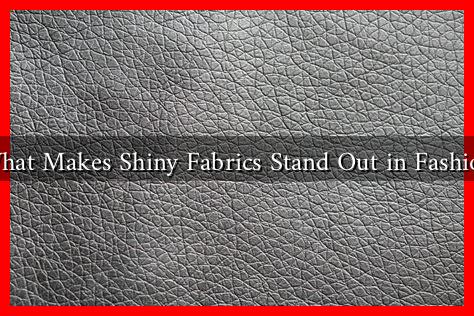-
Table of Contents
What Makes Shiny Fabrics Stand Out in Fashion
Shiny fabrics have long been a staple in the fashion industry, captivating designers and consumers alike with their unique aesthetic appeal. From high-end couture to everyday wear, these materials add a touch of glamour and sophistication to any outfit. But what exactly makes shiny fabrics so special? In this article, we will explore the characteristics, applications, and cultural significance of shiny fabrics in fashion, providing insights into why they continue to stand out.
The Allure of Shiny Fabrics
Shiny fabrics, such as satin, silk, and sequined materials, are characterized by their reflective surfaces that catch and play with light. This quality not only enhances the visual appeal of garments but also influences the way they are perceived by the wearer and the observer. Here are some key attributes that contribute to the allure of shiny fabrics:
- Visual Impact: The reflective nature of shiny fabrics creates a striking visual effect, making garments stand out in a crowd.
- Texture and Depth: Shiny materials often have a rich texture that adds depth to designs, allowing for intricate layering and detailing.
- Versatility: Shiny fabrics can be used in various styles, from elegant evening gowns to casual streetwear, making them a versatile choice for designers.
Applications in Fashion
Shiny fabrics are utilized across a wide range of fashion categories, each serving a unique purpose. Here are some notable applications:
- Evening Wear: Shiny fabrics are a popular choice for formal attire, such as gowns and tuxedos, due to their ability to exude luxury and sophistication.
- Activewear: Many athletic brands incorporate shiny materials into their designs to create eye-catching workout gear that stands out in the gym.
- Streetwear: Shiny fabrics have made their way into street fashion, with items like metallic jackets and reflective sneakers becoming trendy among urban youth.
Case Studies: Shiny Fabrics in Action
Several fashion designers and brands have successfully harnessed the power of shiny fabrics to create memorable collections. Here are a few notable examples:
- Chanel: The iconic fashion house has frequently used satin and silk in its collections, particularly in evening wear, to evoke a sense of timeless elegance.
- Balenciaga: Known for its avant-garde approach, Balenciaga has incorporated shiny materials into its streetwear lines, challenging traditional notions of luxury and casual wear.
- Versace: The brand is famous for its bold use of shiny fabrics, often featuring metallics and sequins in its runway shows, which have become synonymous with glamour and excess.
Cultural Significance and Trends
The use of shiny fabrics in fashion is not just about aesthetics; it also reflects cultural trends and societal values. For instance, the rise of sustainability in fashion has led to innovative uses of shiny fabrics made from recycled materials. Brands like Stella McCartney are pioneering eco-friendly shiny fabrics that maintain the luxurious feel while being environmentally conscious.
Moreover, shiny fabrics often symbolize celebration and festivity. They are commonly worn during special occasions, such as weddings and parties, reinforcing their association with joy and glamour. According to a survey by the Fashion Institute of Technology, 65% of consumers believe that shiny fabrics make an outfit more suitable for special occasions.
Conclusion
Shiny fabrics stand out in fashion due to their unique visual appeal, versatility, and cultural significance. From high-end evening wear to trendy street fashion, these materials continue to captivate designers and consumers alike. As the fashion industry evolves, the innovative use of shiny fabrics—especially those that prioritize sustainability—will likely play a crucial role in shaping future trends. Whether you’re dressing up for a special occasion or looking to make a statement in your everyday wear, incorporating shiny fabrics into your wardrobe can elevate your style and make you feel confident and glamorous.
For more insights into the world of fashion and fabric trends, visit Vogue.

